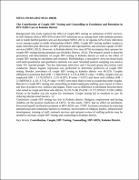| dc.description.abstract | MUSA NOAH (2012-M121-10020)
The Contribution of Couple HIV Testing and Counselling to Enrolment and Retention in HIV/AIDS Care in Koboko District
Background: this study explored the effect of couple HIV testing on utilisation of HIV services. In Sub-Saharan Africa, 60%-95% of new HIV infections occur among those with multiple partners and or stable faithful partners who are discordant (WHO, 2011). In Uganda, 65% of new infections occur among couples in stable relationships (MoH, 2009). Couple HIV testing enables couples to make informed joint decisions on HIV prevention and reproduction; and increases uptake of HIV services (WHO, 2012). However, in Koboko district few men (47%) accompany their spouses for couple HIV testing during antenatal care (Koboko District, 2011). The research aimed to describe prevalence and determinants of couple HIV testing in Koboko district as well as the effect of couple HIV testing on enrolment and retention. Methodology: a descriptive cross-sectional study with both quantitative and qualitative methods was used. Stratified random sampling was used to study 501 married people. Ten key informant interviews and 3 focused group discussions were conducted. Binary logistic regression was performed to determine predictors of couple HIV testing. Results: prevalence of couple HIV testing in Koboko district was 46.52%. Couples affiliated to protestant faith (OR = 2.368 [95%CI: 1.274-4.399], P-value = 0.006), couples who are employed (OR = 3.178 [95%CI: 1.231-8.207], P-value = 0.017) and those with children (OR = 2.138[95%CI: 1.231-3.713], P-value = 0.007) were more likely to test as couple than other couples. Barriers to couple HIV testing and counselling included inadequate staffing, poor layout of clinics and fear of positive test, violence and stigma. There was no difference in enrolment between those who tested as couple and those who did not, 95.1% Vs 96.1% (OR = 0.771 [95%CI: 0.238-2.489]). Desire to be healthy was the reason for enrolment. Couple testing led to retention in care by reducing interpersonal barriers. 12
Conclusion: couple HIV testing was low in Koboko district. Religion, employment and having children are the positive predictors of CHTC. In this study, CHTC had no effect on enrolment. Perceived benefit facilitated enrolment in HIV/AIDS care. CHTC facilitates retention by reducing interpersonal and community barriers to retention. Involvement of religious leaders, infrastructure development, training of staff, outreach services and national review of staffing policies may be needed to increase couple HIV testing and counselling in Koboko district.
Key Words: Contribution, Couple, HIV Testing, Counselling, HIV/AIDS, Koboko District. | en_US |


